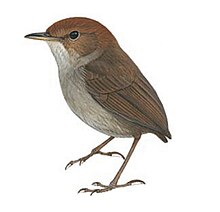
Red-cheeked squirrels are species of squirrels in the genus Dremomys in the subfamily Callosciurinae. The six species which are all found only in Asia are listed as "Least Concern" by the IUCN.
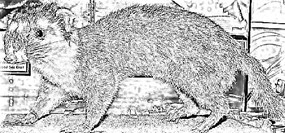
The Bornean ferret badger, also known as Everett's ferret badger or the Kinabalu ferret badger, is a small, nocturnal and omnivorous mammal that is endemic to the island of Borneo. It is a member of the family Mustelidae and is one of six species of the genus Melogale. It is listed as endangered on the IUCN Red List of Threatened Species due to its small distribution range, which includes Kinabalu National Park and Crocker Range National Park.

The blue-backed parrot, also known as Müller's parrot is a large, endangered species of parrot endemic to the Philippines. It is found in tropical moist lowland forests. Flocks are small and often active at night. Its main threats are habitat loss and trapping for the pet trade.

The Philippine forest rat is a species of rodent in the family Muridae. It is found only in the Philippines, and is located throughout the archipelago. The scientific name commemorates British colonial administrator and zoological collector Alfred Hart Everett. R. everetti is widespread throughout its range and feeds on a diet of worms and insects. There are no major threats to the species, which has been found to be competitively superior to introduced Rattus species.

The chestnut-headed tesia is a small insectivorous songbird formerly of the "Old World warbler" family but nowadays placed in the bush warbler family (Cettiidae).

The tesias are a genus, Tesia, of Old World warbler. Though once included in the large family Sylviidae, more recent research placed it within a new family, Cettiidae. The four species inhabit undergrowth of montane forest in South and Southeast Asia, where they are resident or short-range migrants. They have longish legs and appear tailless, with (seemingly) only 8 rectrices. Their simple songs are fairly loud, and their nests are typically ball-shaped. Their name is derived from Tisi, the Nepalese name for the grey-bellied tesia.
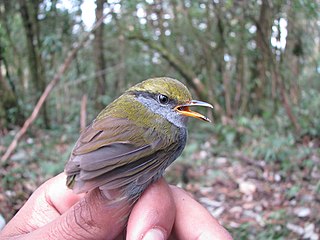
The grey-bellied tesia is a species of warbler in the family Cettiidae.

The slaty-bellied tesia is a species of warbler in the family Cettiidae.

The Javan tesia is a species of Old World warbler in the family Cettiidae. It is endemic to Java in Indonesia. The Javan tesia is a small tesia with long legs and almost no tail. It feeds on insects in the undergrowth of broadleaf forest.

Rentapia everetti, also known as Everett's Asian tree toad or marbled tree toad, is a species of toad in the family Bufonidae. It is endemic to Borneo and occurs in both Malaysia, Brunei, and Indonesia.
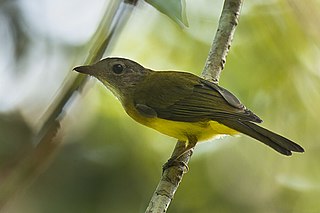
The yellowish bulbul is a species of songbird in the bulbul family, Pycnonotidae.

The Bornean spiderhunter is a species of bird in the family Nectariniidae. The scientific name commemorates British colonial administrator and zoological collector Alfred Hart Everett.

The yellow-vented flowerpecker is a species of bird in the family Dicaeidae. It is found in Bangladesh, Bhutan, Brunei, Cambodia, China, India, Indonesia, Laos, Malaysia, Myanmar, Nepal, Singapore, Thailand, and Vietnam. Its natural habitats are subtropical or tropical moist lowland forest and subtropical or tropical moist montane forest. Along with D. melanoxanthum, D. agile, and D. everetti, it is often referred to as an “odd” Dicaeum species because of unique characteristics separating it from other species within the family. While most species have vestigial outermost primary feathers, those of the yellow-vented flowerpecker are elongated.
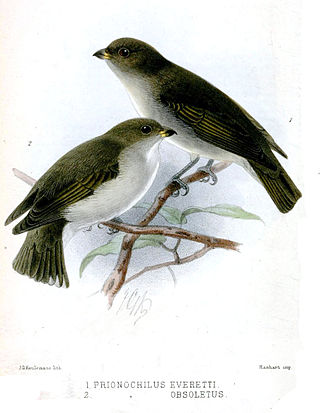
The brown-backed flowerpecker is a species of bird in the family Dicaeidae. The scientific name commemorates British colonial administrator and zoological collector Alfred Hart Everett.
The Tanahjampea monarch or white-tipped monarch is a species of bird in the family Monarchidae. The scientific name commemorates British colonial administrator and zoological collector Alfred Hart Everett.

Everett's thrush is a species of bird in the family Turdidae. The name commemorates British colonial administrator and zoological collector Alfred Hart Everett.

The Bornean mountain ground squirrel is a species of rodent in the family Sciuridae. The scientific name commemorates British colonial administrator and zoological collector Alfred Hart Everett.
Alfred Hart Everett was a British civil servant and administrator in Borneo as well as being a naturalist and natural history collector.

Everett's scops owl is an owl, endemic to the Philippines, belonging to the family of the typical owls Strigidae. Everett's scops owls feed at night on insects. They live alone or in monogamous pairs. They breed throughout the year, laying clutches of 1 or 2 eggs. They nest in tree hollows in forests of the Philippine lowlands. They are found on Bohol, Samar, Biliran, Leyte, Mindanao and Basilan. They were formerly classified as a subspecies of the Philippine scops owl.

The spot-throated flameback is a species of bird in the family Picidae. It is endemic to the Philippines only being found in the province of Palawan in the islands of Balabac, Busuanga and Calamian and mainland Palawan.. It is sometimes considered a subspecies of the common flameback.It is found in moist lowland forests including primary, secondary and even plantations and clearings provided there are still standing trees. It is threatened by habitat loss.
